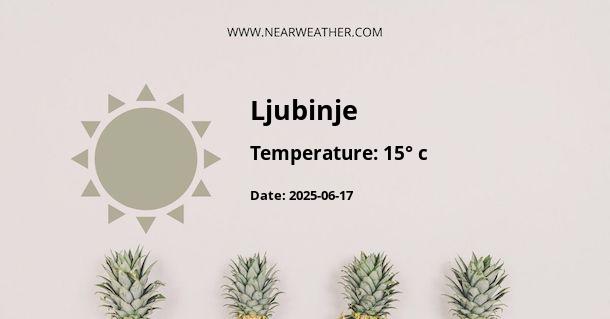Understanding the Climate and Weather of Ljubinje, Bosnia and Herzegovina
Ljubinje is a town located in the southern part of Bosnia and Herzegovina, characterized by its distinct continental-Mediterranean climate. Understanding the intricacies of its weather patterns is essential for both residents and visitors to prepare for seasonal variations and grasp the environmental factors that shape the region's unique climate.Geographic and Climatic Overview
Ljubinje lies in the Herzegovina region, which is known for its complex topography. This small but historically significant town is situated at an elevation, contributing to its specific climatic conditions. The interplay between its geographical latitude and elevation results in a blend of continental and Mediterranean influences on the local weather.
Temperature Patterns in Ljubinje
The temperatures in Ljubinje exhibit a range typical for continental climates, with marked differences between the summer and winter months. Summers can be particularly hot due to the Mediterranean influence, with average high temperatures often reaching above 30°C (86°F) during July and August. In contrast, winters are moderately cold, with average lows in January often dropping to around 0°C (32°F).
Precipitation Trends
Precipitation in Ljubinje is moderately distributed throughout the year, with a tendency for drier conditions during the summer months. Spring and autumn are usually the wettest seasons, which can help maintain local water reserves and contribute to the lush vegetation of the area.
Snowfall and Winter Conditions
While Ljubinje's winters are not extreme, snowfall is not uncommon due to its elevation. Snow can blanket the town and surrounding areas, occasionally leading to disruptions and providing a seasonal shift that is integral to local ecosystems.
Seasonal Weather Variations
- Spring: A season of transition, spring in Ljubinje sees a gradual increase in temperatures and a moderate amount of rainfall. This period is characterized by a mix of sunny days and occasional rain showers, which contribute to the blooming of local flora.
- Summer: Ljubinje's summers are hot and generally dry, with occasional thunderstorms. The Mediterranean influence is strongest during this season, encouraging outdoor activities and agriculture.
- Autumn: The autumnal months bring cooler temperatures and increased precipitation compared to summer. This is a period of gradual change, preparing the natural landscape for the winter months ahead.
- Winter: Winters are relatively mild but can present cold snaps and snowfall. This season sees shorter daylight hours and cooler climate conditions, which can influence daily life and energy consumption.
Wind Patterns
The wind in Ljubinje can vary significantly, influenced by its valley location and the surrounding mountainous terrain. Sudden gusts and breezes are not uncommon, and they can affect temperature perception, especially during colder months.
Year-Round Climate Data
A precise understanding of Ljubinje's weather can be gleaned from meteorological data spanning multiple years. This data provides valuable insights into long-term trends and patterns.
| Month | Avg. High (°C) | Avg. Low (°C) | Precipitation (mm) |
|---|---|---|---|
| January | 7.2 | -1.3 | 69 |
| February | 8.6 | 0.3 | 76 |
| March | 12.3 | 3.4 | 82 |
| April | 16.5 | 7.3 | 85 |
| May | 21.5 | 11.8 | 86 |
| June | 25.4 | 15.7 | 72 |
| July | 28.6 | 18.1 | 50 |
| August | 28.3 | 17.6 | 54 |
| September | 24.8 | 14.8 | 72 |
| October | 19.4 | 10.2 | 91 |
| November | 13.5 | 5.4 | 120 |
| December | 8.8 | 1.5 | 96 |
As we observe from the table, the warmest months are July and August, while the coolest are January and December. Precipitation peaks during the autumn and winter months, with November typically being the wettest.
Expert Opinions and Research
According to climatologists, the changing global climate may influence the weather patterns experienced in Ljubinje. Longer dry spells during summer and intense precipitation events during other seasons could become more frequent. Understanding these changes is critical for adapting local agricultural practices, water management, and infrastructure.
Local Adaptations to Climate
Residents of Ljubinje have traditionally adapted their lifestyle to the climate. Agriculture, for example, follows the seasonal patterns, with crop selection and harvesting times designed to make the most of the local weather conditions. Buildings are commonly constructed with materials and insulation suitable for both the hot summers and cool winters.
The Unique Charm of Ljubinje's Weather
Ljubinje's weather contributes greatly to its charm and the diversity of activities available throughout the year. From summer festivals to winter traditions, the climate not only shapes the environment but also the cultural tapestry of the town. Understanding and appreciating the nuances of Ljubinje's climate can enrich the experience of living in or visiting this unique corner of Bosnia and Herzegovina.
In conclusion, the climate and weather of Ljubinje are emblematic of the town's unique position at the crossroads of continental and Mediterranean influences. Recognizing the patterns and fluctuations of this climate provides a foundation for understanding the rhythms of life in this region.
A - Ljubinje's Latitude is 42.950829 & Longitude is 18.088610.
A - Weather in Ljubinje is 16° today.
A - Climate Conditions in Ljubinje shows clear sky today.
A - Humidity in Ljubinje is 49% today.
A - Wind speed in Ljubinje is 10.33 km/h, flowing at 65° wind direction. today.
